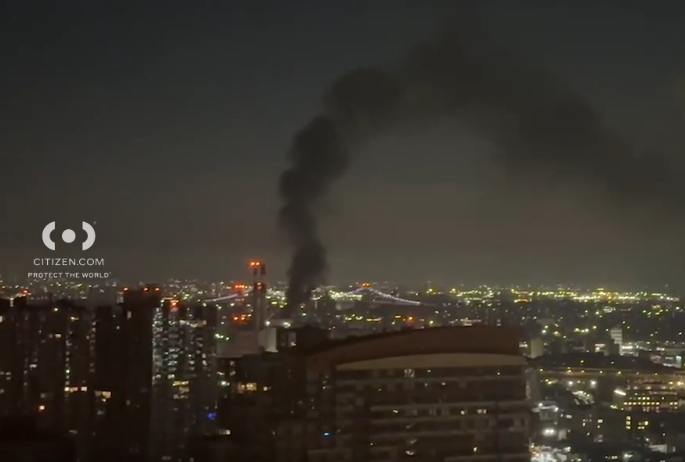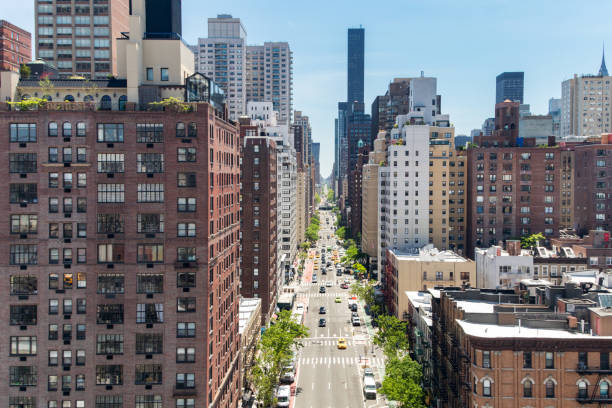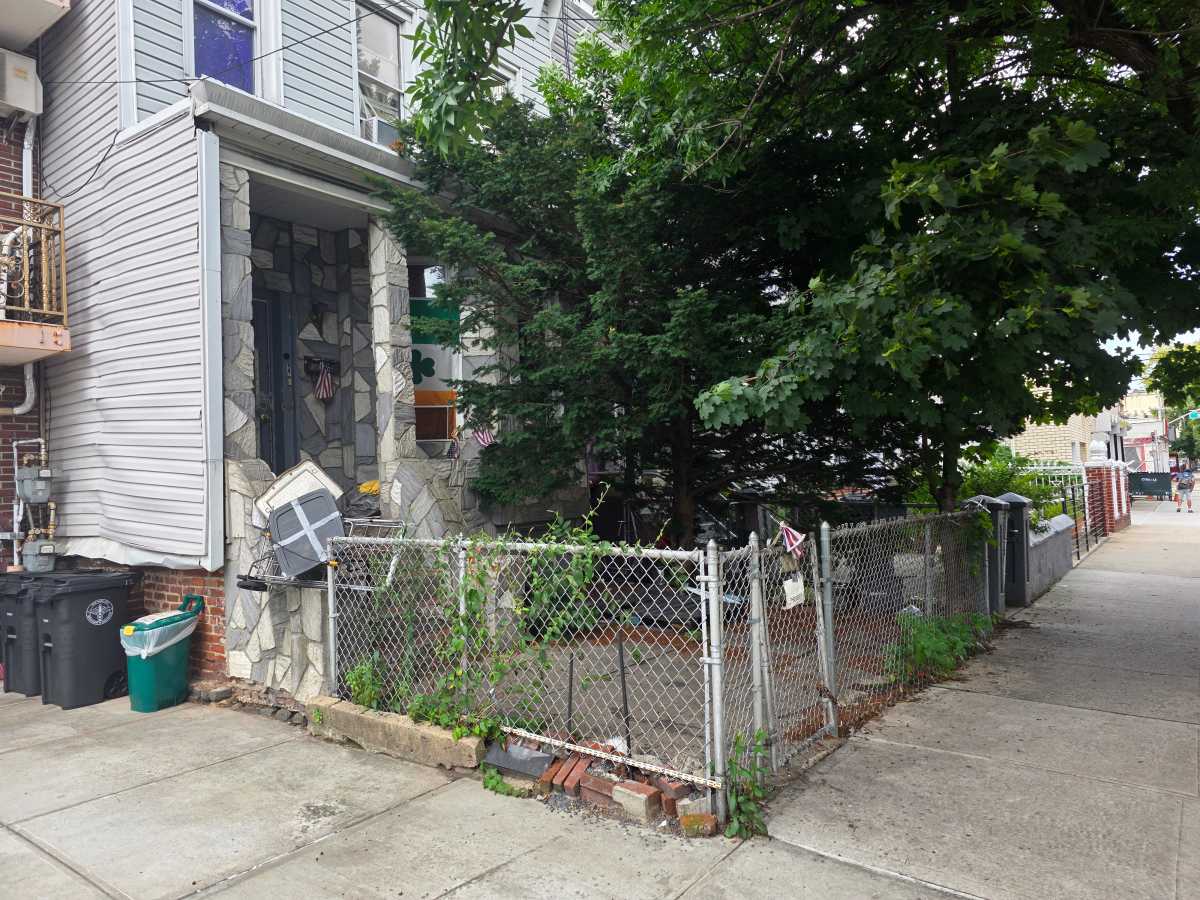
BY LINCOLN ANDERSON | Members of N.Y.U. Faculty Against the Sexton Plan last Friday led mayoral candidate Sal Albanese on a tour of the university’s two superblocks, pointing out how the area would be impacted by the university’s N.Y.U. 2031 mega-development project.
The tour with Albanese came exactly one week after the faculty of Arts and Sciences, New York University’s largest school, voted “no confidence” in President John Sexton.
Leading the tour were Bo Riccobono, first vice chairperson of Community Board 2, and Terri Cude, co-leader of Community Action Alliance on N.Y.U. 2031, a.k.a. CAAN. Riccobono is also an adjunct N.Y.U. professor. Albanese himself received his master’s in health sciences from N.Y.U. A former 15-year city councilmember, he is the only candidate in the race who has pledged not to take developers’ money.
“Everywhere I go, it’s an issue,” he said about New Yorkers’ concerns about overdevelopment in their neighborhoods.
“They’re going to build inside here, they have two towers,” Riccobono said, pointing to the northern block.
“They want to put in a series of buildings, up to 25 stories — very dense,” Cude chimed in.
Absorbing the information, Albanese said, “So you’re opposed to the whole thing?”
Indeed, Cude, Riccobono and N.Y.U. FASP are part of the 11 community groups who are plaintiffs in the Article 78 lawsuit seeking to overturn the city’s approval last summer of N.Y.U.’s application for the plan. The ambitious $6 billion scheme would add around 2 million square feet of development to the two superblocks, located south of Washington Square Park and north of Houston St.
Faculty members Chris Collins, a linguistics professor, and Jeff Goodwin, a sociology professor, filled in the mayoral hopeful on the faculty’s displeasure about the plan for the two supersized blocks, where nearly 40 percent of the school’s faculty live.
“So there was no consultation? There was no in-depth conversation with the faculty?” Albanese asked.
Riccobono explained that it was only after the ULURP application for the scheme was approved last summer that the university created the so-called “Space Committee,” a Committee on Open Space to discuss the plan with faculty.
What about political opposition to the plan, at least? Albanese asked.
“No, none,” Riccobono said. “The only one was [Assemblymember] Deborah Glick. She’s a co-plaintiff in the lawsuit.”
Not even the local councilmember? Albanese asked, referring to Margaret Chin.
“She’s under the influence of Quinn,” Riccobono explained, referring to City Council Speaker Christine Quinn.
“The City Council’s a dictatorship,” Albanese quipped with a smile.
However, the opponents noted, Chin’s predecessors, former Councilmembers Alan Gerson and Kathryn Freed, both recently filed affidavits in support of the community lawsuit against N.Y.U. 2031. And before them, former Parks Commissioner Henry Stern, the city’s longest-serving Parks commissioner, also submitted an affidavit for the lawsuit. Stern, Freed and Gerson all say that it was their clear understanding that the four open space strips along the superblocks’ Mercer St. and LaGuardia Place edges were parkland.
“The community board opposed it unanimously,” Riccobono added of the university’s plan.
On LaGuardia Place, Albanese posed briefly in front of the statue of Fiorello LaGuardia, his favorite former mayor.
They passed Adrienne’s Garden, a new playground set to open in April.
“But they know that it’s temporary,” Riccobono noted, adding it would have to go to make way for the N.Y.U. construction.
Walking through the serene Sasaki Garden, in the Washington Square Village courtyard, Cude noted, “N.Y.U. is hoping to have a lot of cross-traffic through here for their students going down to the new building on the south block. There are 1,200 people in these four buildings.”
Pointing to the trees, she said, “These are weeping cherries. They come back in a month and they’re spectacular.”
“It’s such a peaceful area in the city, and it’s going to be gone,” said Collins of the tranquil garden, where two new infill buildings are planned.
“Look at these old-growth trees,” added Therese Watson, who was on the tour with her husband, Adam Becker, a professor of religious studies and classics.
They passed the Mercer Playground, located on one of the strips, which certainly looks, to all appearances, like an official Parks site. It has Parks signage, plus a yardarm-style flagpole (which Stern added to all city parks) flying a Parks flag and the American and New York City flags.
“N.Y.U. wants to turn this into an access plaza to a building that will be on what’s now the Key Park,” Cude explained.
As further proof of the strip’s status, she and Collins pointed to an official Parks sign on the fence at the Bleecker St. end of Mercer Playground.
“In 1995,” the green placard notes, “the Department of Transportation gave Parks a permit to use the site. Two years later the site was formally transferred to Parks, and plans were made for capital improvements.”
“Take that sign!” Collins said, making as if to grab the “evidence” and pull it off the fence.
Passing Coles gym, Cude noted how, based on an agreement with the community, N.Y.U. had created an outdoor playground on top of the gym. But accessing the rooftop space was an issue, so a playground was instead created on the Mercer St. strip, which the university then let fall into disrepair. For years, the playground — which looks like an earthquake hit it — has been locked to the public.
“The homeless guys break the padlock so they can sleep in there,” Cude explained of the space that the university had pledged as a community playground.
“I’ve learned a lot,” Albanese said at the walk’s end. “This was a very revealing tour.”
But he said he wasn’t ready to make a pronouncement on the N.Y.U. plan just yet, and was looking forward to more information from the opponents.
Asked about the four open space strips, he said, “It seems to me like it’s parkland. These signs clearly indicate that it’s Parks Department property.”
However, Philip Lentz, an N.Y.U. spokesperson, said of the strips: “Signage does not convey ownership.” He also noted that a 1995 letter from Eliot Sander, then commissioner of the Department of Transportation, to Stern, stated that the transfer of the future Mercer Playground site from D.O.T. to Parks was only temporary and that D.O.T. could take it back later.
Lentz referred The Villager to the city’s Law Department for confirmation of that opinion.
A Law spokesperson said the sign was “a mistake.”
“The sign [on Mercer Playground] mistakenly states that the parcel is in the jurisdiction of the Parks Department,” the spokesperson said. “In fact, it is mapped street that is in D.O.T.’s jurisdiction. Former Commissioner Stern, in an affidavit filed by the petitioners, concedes that the parcel was never formally transferred to Parks.”
The Parks Department did not respond to requests for comment by press time.
Randy Mastro, the plaintiffs’ attorney, said the “temporary use” letter from 1995 is outdated, since the site was formerly dedicated two years later as a park in a grand opening ceremony, and furthermore, that the letter has been rendered moot by the park’s heavy public usage as a park in all these years since — in other words, that usage as well as public perception of the site as a park are what really determine its true nature.
Mastro said if any one of the four disputed strips is ruled to be parkland by the judge, it would set back the N.Y.U. 2031 plan, because the studies and approvals for the plan were premised upon the use of all four strips: three have 20-year easements to allow the construction project, while the strip east of the Coles gym — now home to the Mercer-Houston Dog Run — would be partially covered by the footprint of the planned new “Zipper Building.”
In her affidavit, Freed said she never would have allocated Council funds for the Mercer Playground had she known it was only going to be just temporary parkland.
In a phone interview on Wednesday, Gerson said the lawsuit could have major ramifications.
“This case has the potential to set a citywide precedent for green space that is functioning as parkland but is being held by an agency other than the Parks Department,” he noted.
Gerson said the case will be a verdict on whether the city’s tactic of trying to keep the parcels under the jurisdiction of another agency is a valid way to avoid “alienation” of parkland — the process of removing property from park use, which must be approved by the state Legislature.

































